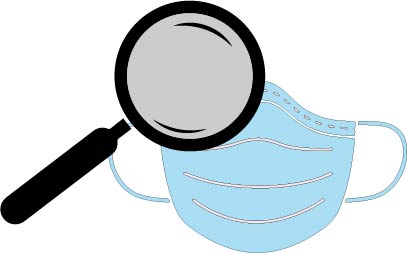Forensic Science and COVID-19
Correlations between the development of forensic science and COVID-19
For over a year now, the outbreak of the COVID-19 virus has completely changed the way in which human beings go about their lives and everyone has been forced to learn how to adapt. There has also been a change in forensic science, as COVID-19 has impacted that field as well. Between forensic science investigation and the coronavirus. Forensic science can be employed anywhere, and with the prevalence of COVID-19, the research connecting the two subjects offers benefits by providing additional information that demonstrates these correlations on a global scale.
Although it is not exactly clear when forensic science first appeared, according to Origins of Forensic Science, “most historical experts agree that it was very likely in China around the 6th century or earlier.” Modern forensic science took decades to evolve and is still considered a fairly new field of science that professionals are still developing.
One important researcher worth mentioning is a French criminologist named Edmond Locard, who is considered to be the father of modern forensic science. He created the first ever crime investigation lab in 1910 to analyze evidence collected from crime scenes. He also created his famous exchange principle in 1940, which will be further explained below, and according to “Principles of Trace Evidence,” “is the basis of all forensic science as we know it today.” In a 2020 article titled “Can forensic science learn from the COVID-19 crisis?” the authors, Roux and Weyermann, explore the different aspects in which forensic science and covid correlate.
First, Roux & Weyermann mention that both forensic science and COVID-19 help to answer the same type of questions, such as “what causes the disease/death of a person?” or “when and how did the disease/crime occur?” During the COVID-19 pandemic, reconstruction is valuable, as it is when used in forensic science. An example of this is that when a person tests positive for COVID-19, public health officials need to reconstruct the chain of events through interrogation and isolate individuals who were in close contact.
The reconstruction process is challenging with COVID-19 because most individuals develop the first symptoms of the disease well after they are contagious. Reconstruction of past activities is also fundamental to police investigations, and with time being of the essence, evidence such as memory and traces are only available for a limited time.
In an interviewing Professor Grant Patient, lecturer and member of the Criminal Justice Department at UW-Platteville had some interesting concepts that contribute to the idea that forensic science and COVID-19 correlate. When asked, “Do you think that forensic science and covid impact and/or influence each other?” he replied, “Absolutely.” The first idea he brought up was that there are new strands of the virus now, and they are forensic science related because of the way forensic scientists continue to do research and develop new technology: scientists are doing this now with the coronavirus, studying and researching the variants it has. Another concept Patient mentioned is that forensic investigation uses trace evidence, as in Locard’s Principle of Exchange, to determine where a piece of evidence originated from. Locard’s Exchange Principle is the idea that “Every contact leaves a trace.” Therefore there is always an exchange between victim, perpetrator and scene, that links people to a crime and is a revolutionary concept to crime-solving.
The same concept applies to COVID-19 as public health officials attempt to trace where the coronavirus came from, where it spread to, and who has been in contact. Patient also added that “Covid is an exchange.” People carry and spread the virus and ultimately infect more individuals. Another correlation Patient mentioned is the fact that from January 2020 to now, COVID-19 had created a huge crime scene. The lockdown allowed isolation away from the coronavirus while scientists investigate what is going on in the world and causing so much death.
Professor Daniel Román, also a lecturer and member of the Criminal Justice Department at UW-Platteville, gave his input on the subject, as did his colleagues who are actively working in the field. Román said that “wearing PPE is a standard to avoid transferring fingerprints or possible DNA transfers at crime scenes, and wearing masks, while optional in most cases to limit DNA contamination, has now become a standard practice to keep the officers from being exposed to the Covid virus.”
Patient also discussed that antibodies lasted around 90 days after an individual is diagnosed with COVID-19, but sometimes professionals can see that after six months or more the covid antibodies are still present. He also mentioned that, because of this, forensic investigators can determine if the deceased had previously had COVID-19 or not.
In another article titled, “Influence and challenge of COVID-19 in forensic identification” by Cong & Liu, the authors discussed how “autopsies performed by forensic pathologists on patients who died of COVID-19 have revealed the disease pathogenesis in terms of gross morphology and histopathology, especially the status of tissues and organs affected by the virus.” Pathogenesis is “the development of a disease and the chain of events leading to that disease,” according to the definition provided by medical editor Melissa Conrad Stöppler, MD.
Additionally, gross morphology “refers to the collection of structures of an organism as a whole as a general description of the form and structure of an organism, taking into account all of its structures without specifying an individual structure.” The article continues to explain that these autopsies have made major contributions to determine the cause and mechanisms of death.
Acknowledging the fact there are correlations between forensic science and COVID-19 is important because it offers more knowledge on how both subjects affect one another. Further research on forensics and COVID-19 offers beneficial information that can help forensic science continue to develop and lead to a better understanding of the coronavirus pandemic the world currently lives in. Forensic science is needed now more than ever.




